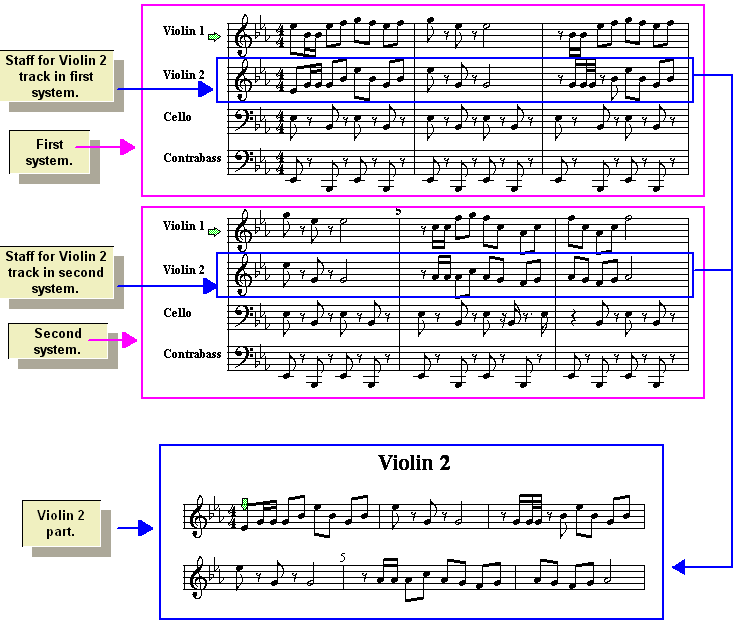|
<< Click to Display Table of Contents >> Understanding Tracks, Staves, and Parts |
  
|
|
<< Click to Display Table of Contents >> Understanding Tracks, Staves, and Parts |
  
|
It is important to understand how Musician defines the terms staff and part. These two terms are closely related, yet they have distinct meanings in Musician, and are used extensively in Musician's user interface. For example, Musician's main menu includes both a Staff menu and a Part menu.
If you have worked with MIDI sequencing software, then you are probably familiar with the term track. The relationship between a staff in Musician and a MIDI track is explained at the end of this topic.
The following excerpt from the string section of Tchaikovsky's 1812 Overture: illustrates the relationships between staves and parts. The remainder of this topic explains these terms.

The above example illustrates:
| two systems on a page of the string section from the conductor's score |
| four staves per each system, for Violin 1, Violin 2, Cello, and Contrabass |
| the Violin 2 part extracted from the conductor's score |
System
A system is one line of music played together by possibly multiple instruments and voices. In the top half of the above example, there are two systems, that is, two lines of music. A system break is like a line break in a text documentation, where a sentence ends at the right side of the page and continues below on the page or at the beginning of the next page.
Staff
In strict music terminology, a staff is the set of five (or sometimes a different number of) staff lines that hold the notes for a particular instrument or voice in one system (line of music). Music software programs have traditionally departed from this strict definition of the term staff, and so does Musician. A staff is defined as all of the music (and all MIDI details) played by given instrument or voice across all of the systems and pages in the score.
Part
In Musician, the most common example of a "part" is the music played by one instrumentalist or vocalist (or multiple musicians performing the same part). The part is the sheet music that lies on the music stand in front of the musician.
Vocal parts and single-melody instruments usually have just one staff. Piano parts usually have two staves for the right and left hands.
The "conductor's score" is a special part that shows all of the staves in the score.
The currently selected part is displayed in the main menu. You can view a different part by selecting in the dropdown list of part names:

A part can be formatted and paginated independently of other parts extracted from the conductor's score. You can choose special formatting options for the display of a given part. You can also control the page breaks and system breaks (at particular measures) for that part. You can assign a name to that part and later recall it, so that only the staves assigned to that part are displayed, and the saved formatting options and pagination details are restored.
One of the powerful features of Musician, which you will not find in many other music notation programs, is that all "extracted" parts of a score remain perfectly synchronized with the full conductor's score. If you add a note for, say, the Violin 2 part in the conductor's score, it will also be added in the separately extracted, formatted and paginated Violin 2 part. Conversely, if you are viewing the Violin 2 part, and add a note to it, the next time you view the conductor's part, you will see that the note was added there also.
Potential Confusion between the Terms 'Staff' and 'Part'
This terminology is potentially confusing, because Musician's definition of staff is what some musicians might say is a "part". When a musician talks about a "part", is he referring to his lines (staves) of music in the conductor's score, or is he referring to the sheet music on his music stand that he plays from? Both concepts of the music are commonly called "part", but Musician needs to distinguish the two concepts.
If at first you are confused about the difference between the terms staff and part, you might find it helpful to think about piano music. A solo piano piece has just one part-- the piano part. But the solo piano piece has two staves-- the right- and left-hand staves.
Relationship between Staff and MIDI Track
In Musician, there is exactly one MIDI track for each staff. If an instrument has two staves, then it has two MIDI tracks. If you are familiar with MIDI and MIDI sequencers, you can think of "staff" as being a MIDI track for which the music notation is displayed.
Some other music software programs, called "MIDI sequencers", offer a "staff view", which is an automatic transcription of the notes in the MIDI track. In Musician, the notes displayed in the staff are similarly automatically transcribed. However, after the notes have been recorded and transcribed, in Musician you can further refine the notation (such as the interpretation of rhythms) while optionally leaving the underlying MIDI performance unchanged.